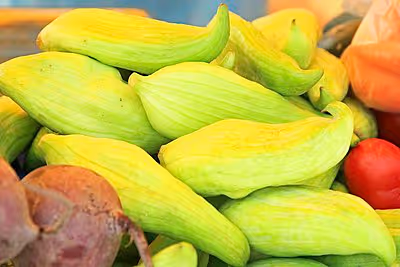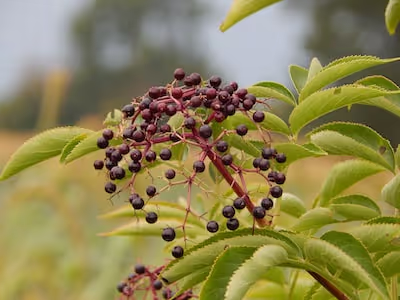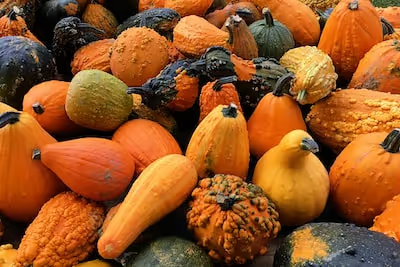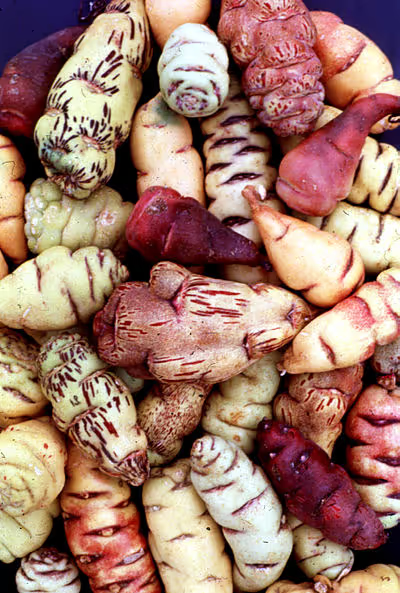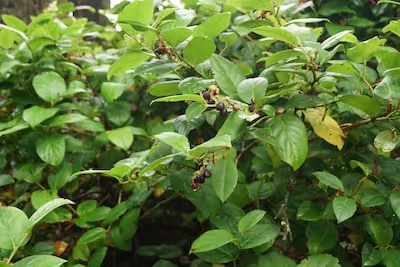Growing Wasabi at Home: Your Guide to Fresh Flavor
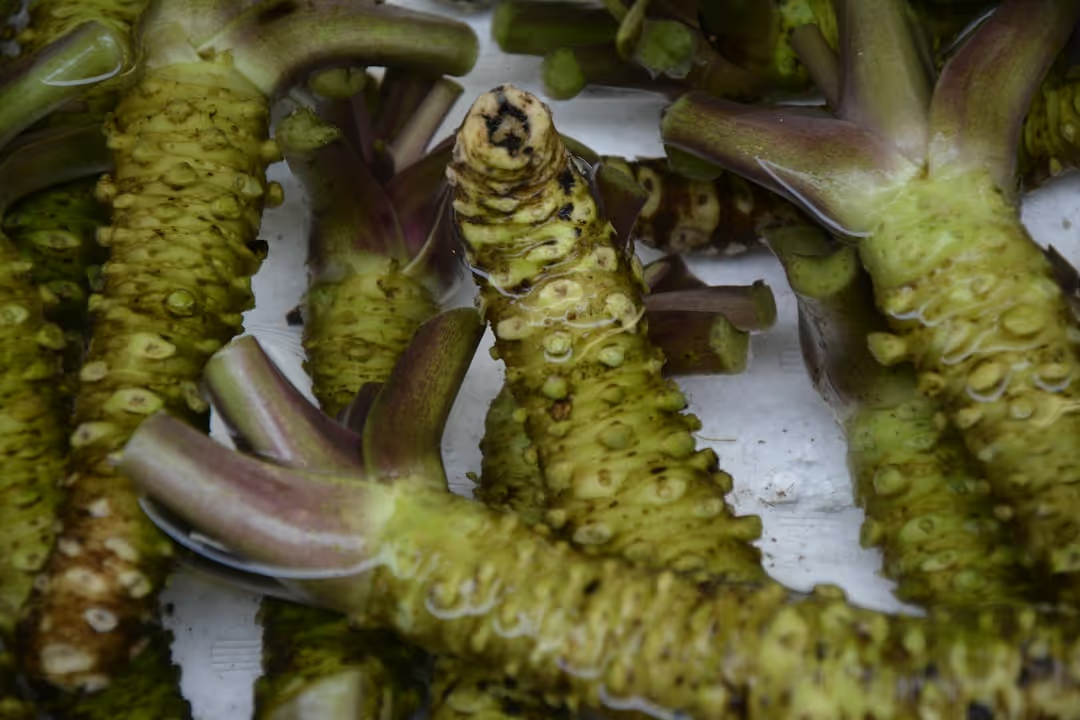
Growing Wasabi
Growing wasabi at home transforms a cool, shady corner into your personal fresh rhizome stash. Real wasabi thrives in steady temperatures around 50-60°F, shaded sunlight, and consistently moist soil or shallow running water. Understand these conditions and you'll master the rare pleasure of growing wasabi successfully—read on to discover every practical step you need.
Cheatsheet: Home Wasabi Growing Essentials
🌱 Location & Requirements
- Shade: Needs 75%-90% shade or dappled light
- Temperature: 45-75°F (7-24°C) year-round
- Humidity: 60-80% ideal
- pH: 6-7
- Airflow: Maintain to reduce fungal disease
🪴 Planting Setup
- Use large pots (at least 12 in / 30 cm deep)
- Soil: Rich, well-draining, high in organic matter
- Water: Keep soil moist, never soggy
- Hydroponic: Constant trickle with aquarium pump
📅 Propagation & Growth
- Start from rhizomes or tissue-cultured plantlets
- Plant 2 in (5 cm) deep, cover rhizomes lightly
- Roots grow slowly—harvestable in 18–24 months
- Spread mulch to maintain cool, damp soil
💧 Water & Care
- Water daily; avoid standing water
- Fertilize monthly with balanced, slow-release feed
- Watch for slugs, snails, aphids, root rot
- Rotate pots for even growth
🔪 Harvest & Storage
- Harvest when rhizomes reach 6 in (15 cm) thick
- Trim leaves for salads; use stems & flowers
- Grate rhizome fresh—flavor fades in 15 min
- Store unwashed in fridge; keeps 2-4 weeks
💡 Health & Nutrition
- Rich in isothiocyanates—natural antimicrobial
- Low calories, high in vitamin C, fiber
- 98% of “wasabi” sold is horseradish—grow real flavor
🛠️ Tools and Products You’ll Need
- Wasabi plantlets/rhizomes
- Pots & trays
- Organic soil mix & compost
- Balanced fertilizer
- Shade cloth or filtered light area
- Drip irrigation or watering can
- Grater (sharkskin or ceramic preferred)
- Sticky slug traps
🌤️ Step 1: Choose Shady Location
Set up pots in cool, shady spot; avoid direct sun.
🦠 Step 2: Plant Wasabi Starts
Plant rhizome or seedling 2 in (5 cm) deep in loose, moist soil.
💧 Step 3: Maintain Water & Humidity
Water soil daily; never let soil dry out or get soggy.
🌱 Step 4: Feed & Mulch
Add fertilizer monthly; mulch to keep roots cool.
🔍 Step 5: Monitor for Pests
Check leaves and soil daily; remove slugs, treat aphids.
✂️ Step 6: Harvest & Enjoy
Harvest rhizome after 18–24 months; grate fresh for peak flavor.
-
Growing Wasabi: flavor, botany, and the thrill of the grind
I grow Wasabia japonica for the moment a fresh, pale-green paste lights up the sinuses and vanishes like mist. The heat comes from isothiocyanates, volatile compounds that peak quickly and fade within minutes.
The first time I lifted a tight green rhizome from cool gravel, it felt like discovering a truffle underwater. I grated it, waited 90 seconds, and the bite hit clean and sweet, then slipped away before the sushi rice cooled.
Climate sweet spot
Think cool, damp, and shaded with steady airflow. My best plants sit at 50 to 60 F, 10 to 16 C, under 80 to 90 percent shade with high humidity.
Oregon State University Extension and the Royal Horticultural Society describe wasabi as a plant of stream margins, so I mimic a creek edge without the flood. I use moving air and never let the crown sit in stagnant water.
Expect 18 to 24 months from transplant to a harvestable rhizome, and about 1 to 1.5 pounds per square yard under dialed-in conditions.
Outdoors vs indoors
- Outdoors: Best in mild maritime climates, USDA zones 7 to 9, with summer highs under 80 F, 27 C. I tuck plants on the north side of a wall with heavy mulch and drip.
- Indoors: Basement or garage at 45 to 70 F, 7 to 21 C, with humidifier and fan. I use 75 to 85 percent shade cloth or LED set to 60 to 120 µmol m⁻² s⁻¹.
Light and shade
Wasabi sunburns fast. I aim for 1,000 to 1,500 foot-candles, roughly 10 to 16 klux, soft and even.
Under LEDs, dim to a gentle PPFD and raise fixtures until petioles stand upright but leaves stay thick and dark. If leaf edges bronze, back off the photons.
Water, media, and pH
Even moisture is the religion here. I water with cool, clean water, keep the medium damp like a wrung-out sponge, and let air move through the root zone.
My container blend: 40 percent fine bark, 40 percent perlite, 20 percent peat or coir, plus a pinch of dolomite to hold pH at 6.0 to 6.5. In beds, I mix compost into a gravelly loam and mound the crown slightly.
Fertilizer program
I feed light and frequent with nitrate-leaning nitrogen. For containers, I run a leafy-greens formula at EC 1.2 to 1.6 and keep calcium and magnesium steady to firm the tissues.
Yellow new growth points to low nitrogen or iron. Pale margins with tip burn often means salt buildup, so I leach with plain water and resume at half strength.
Propagation and plant sourcing
Seeds exist, but germination is fickle and slow, and seedlings vary wildly. I prefer tissue-cultured plantlets or divisions with two to three leaves and a stub of crown.
Reputable suppliers offer cultivars like Daruma and Mazuma as starts, usually shipped in spring. Expect 8 to 18 USD per plant, or 10 to 20 GBP, with bulk trays costing less per plug.
Potting and spacing
Start in 4-inch, 10-centimeter pots for four to six weeks, then move to 2 to 3 gallon, 7.5 to 11 liter containers. In beds, space plants 12 to 18 inches, 30 to 45 centimeters, for airflow and easy harvest.
Keep the crown just at the surface. If you bury it, rot lurks; if you expose roots, leaves stall.
Temperature and humidity management
Growth slows above 75 F, 24 C, and stalls above 85 F, 29 C. I cool the root zone with evaporative trays, chilled irrigation, or morning-only watering during heat spells.
Humidity loves to sit near 70 to 90 percent, but leaves need to dry by night. A small fan on low saves more plants than any fungicide in my shed.
Pests and diseases
- Slugs and snails: Beer traps, copper tape, and midnight patrols with a headlamp. Any chew marks on petioles, I set out more traps.
- Aphids: Soft wash with insecticidal soap, then release lacewings. Keep nitrogen moderate to slow the honeydew fountain.
- Pythium and Rhizoctonia: They love wet, stagnant media. I prune lower leaves, sanitize tools, and alternate irrigation zones to keep oxygen in the root zone.
- Black leg and leaf spots: Remove infected tissue fast, disinfect pots, and rotate media sources. Good airflow beats sprays most days.
Cultivars I rate for home growers
- Daruma: Thicker rhizomes, steady growth, classic medium heat with sweet finish. My most forgiving starter.
- Mazuma: Longer, punchy heat, great aroma, wants slightly cooler roots and cleaner water.
- Shimane: Leafy and vigorous, handles summer stress better for me, rhizomes a bit slimmer.
- Midori: Tissue-culture lines often show good disease tolerance, handy in containers.
Harvest, prep, and storage
Leaves and petioles eat well within 8 to 12 weeks, with a cucumber-brassica snap. Rhizomes size up from month 12 and hit prime at 18 to 24 months.
To serve, scrub and trim the end, then grate in tight circles on a fine oroshigane or microplane. Wait 60 to 120 seconds, then eat before minute 15, when the magic softens.
Store trimmed rhizomes wrapped in a damp towel in the fridge at 34 to 40 F, 1 to 4 C, and refresh the cut end every few days. I get two to four weeks of excellent flavor that way.
Hydroponic notes
Flood-and-drain or constant trickle works if the water stays cool and oxygenated. I target solution pH 6.0 to 6.3 with a nitrate-heavy feed and keep dissolved oxygen high with airstones.
Warm solution invites root pathogens. A small chiller saves a hydro system in July like a good hat saves a farmer.
Market intel and costs
Fresh rhizome retails in North America at roughly 80 to 150 USD per pound, 176 to 330 USD per kilogram, depending on grade and season. Chefs pay for freshness because the heat is fleeting and irreplaceable.
A starter kit for 6 plants runs about 150 to 350 USD, 120 to 290 GBP, including pots, media, shade cloth, and a small fan. Add 50 to 120 USD, 40 to 95 GBP, for a humidifier if you grow indoors.
Shopping checklist
- Plantlets of Daruma or Mazuma from a reputable nursery or tissue-culture lab.
- Fine bark, perlite, peat or coir, dolomite, and a balanced leafy-greens nutrient.
- 75 to 90 percent shade cloth, clip-on fan, and a small humidifier.
- Drip stakes or a low-flow emitter kit, plus a timer.
- pH and EC pens, because guessing burns money.
- Fine grater or oroshigane for service.
Taste comparisons and alternatives
- True wasabi: Bright, sweet heat that blooms then fades, herbal and clean.
- Horseradish: Sharper, longer burn, more sulfur, easier to grow and cheap.
- Wasabina mustard (Brassica juncea): Fast leaf crop with wasabi-like zing for salads.
- Watercress: Peppery leaf, thrives in similar cool, wet setups, great companion in hydro trays.
My field notes that save crops
- Keep crowns proud. I plant with a slight mound so splash and rot slide off.
- Chill the irrigation. In a heatwave I run morning-only water at 50 to 55 F, 10 to 13 C.
- Mulch with rinsed pea gravel around the crown to stabilize humidity and deter slugs.
- Prune low, old leaves every two weeks to vent the crown and dry the petiole bases.
- Rotate media sources and sanitize pots with a 10 percent bleach rinse between cycles.
Common problems and quick fixes
- Leaf scorch and droop at noon: Too much light or heat. Add 20 percent more shade, cool the roots, and water earlier.
- Soft crown and sour smell: Overwatering without airflow. Increase perlite, lift the crown, and run the fan.
- Dark, slow plants with thick petioles: Feed is too lean. Increase nitrogen slightly and add magnesium.
- Speckled leaves with sticky residue: Aphids. Rinse, soap, then release beneficials.
Serving tricks chefs swear by
Grate in circles to rupture more cells, then pack the paste into a little dome to let the chemistry bloom. Pair with neutral rice or chilled soba to showcase the clean heat.
I shave a touch over raw oysters with a squeeze of yuzu, and it turns a weeknight into a memory. Keep leftovers wrapped tight and regrate the cut face next time.
Anecdote from a shaded corner
I lost a whole bench one August before I learned to cool the irrigation water. The next summer, a $60 aquarium chiller paid for itself in one heatwave.
These plants teach patience, and they pay back with every leaf, every petiole, and that final, perfect grate.
Citations and further reading
Oregon State University Extension outlines wasabi’s need for cool shade, steady moisture, and careful sanitation, and that frame matches my results. Washington State University notes similar cultural needs for brassicas and highlights the role of airflow in disease reduction.
The Royal Horticultural Society recommends deep or partial shade and moist, fertile soils for wasabi in temperate gardens. Industry growers in the Pacific Northwest report 18 to 24 months to marketable rhizomes and price ranges that reflect handling and perishability.
Frequently Asked Questions About Cultivating Wasabi at Home
Can wasabi grow successfully indoors?
Absolutely. Wasabi thrives indoors provided it enjoys consistent temperatures between 45°F and 70°F (7°C - 21°C), ample humidity, and shaded conditions. Replicating the cool, streamside climate native to wasabi encourages healthy rhizome development indoors.
How long does wasabi take until harvest?
Cultivating wasabi tests your patience: expect a wait of around 18 to 24 months before harvesting mature rhizomes. However, leaves and stems can offer a spicy preview after only a few months of growth.
What is the ideal potting mix for homegrown wasabi?
Stick to a fast-draining, moisture-rich soil mix that combines organic compost, sand, and perlite. Wasabi roots demand oxygenated water constantly trickling through a loosely packed medium for best results.
Can wasabi tolerate direct sunlight?
In short, no. Direct sunlight burns and stresses the plant. Opt for a subtly shaded area with diffused, indirect light, mimicking the dappled shade of forest streams where wild wasabi naturally flourishes.
What's causing my wasabi leaves to wilt or discolor?
Wilting or discoloration indicates distress signals like temperature swings, insufficient dampness, or inconsistent watering. Keep your wasabi plants consistently moist and cool, and watch closely for fungal intrusions.
Is it possible to propagate wasabi from existing plants?
Definitely. Wasabi plants generously offer offsets or suckers. Carefully uproot these from mature plants and transplant into fresh, well-aerated soil, ensuring steady moisture and shade cover as they root in their new home.
Growing Wasabi at home is no casual affair—it calls for patience, shade, and a respect for water. But the payoff is real: fresh wasabi is a revelation, worlds apart from the green paste at your local sushi counter. Keep the roots cool, mimic the misty banks of a Japanese stream, and stay vigilant for pests. Start small, celebrate every new leaf, and enjoy the slow satisfaction that comes from nurturing this finicky, flavorful plant. If you like the challenge of growing burdock root or experimenting with rare edibles, wasabi belongs in your patch. In the end, it’s simple: put in the work, reap the spice. That’s what homegrown flavor is all about.
The Homesteader's Guide to Growing Wasabi at Home
Maximizing Space with Wasabi
Grow compactly with containers. A single square meter (10.8 sq ft) of shaded space yields roughly 10 mature wasabi plants—ideal for patios, balconies, or small homestead plots.
Water Self-Sufficiency Tips
- Rainwater Harvesting: Set up a rain barrel; wasabi thrives with chemical-free water.
- Gravity System: Attach an elevated irrigation drip line for sustainable supply.
- Natural Filtration: Use sand and gravel layers in pots or raised beds for clear drainage and healthy rhizomes.
Smart Companion Planting
- Mint & Cilantro: Plant these nearby; their aromatic properties deter aphids and pests.
- Watercress: Shares growing conditions, boosts yield, and improves soil moisture retention.
Boost Your Nutrition Independently
Plant-grown wasabi contains anti-inflammatory allyl isothiocyanate, vitamins C and B6, and minerals like manganese and calcium. Useful for supplementing nutrition sustainably at home without external dependencies.
Creating Your Own Wasabi Paste at Harvest
Use fine-grain sharkskin graters (or ceramic substitutes) to grate fresh rhizomes and preserve pungency, retaining health properties compared to store-bought versions—which often contain horseradish instead of authentic wasabi.
Find out which plants will thrive in your garden!
Answer a few fun questions and get custom plant recommendations perfect for your space. Let’s grow something amazing together!

start your season
